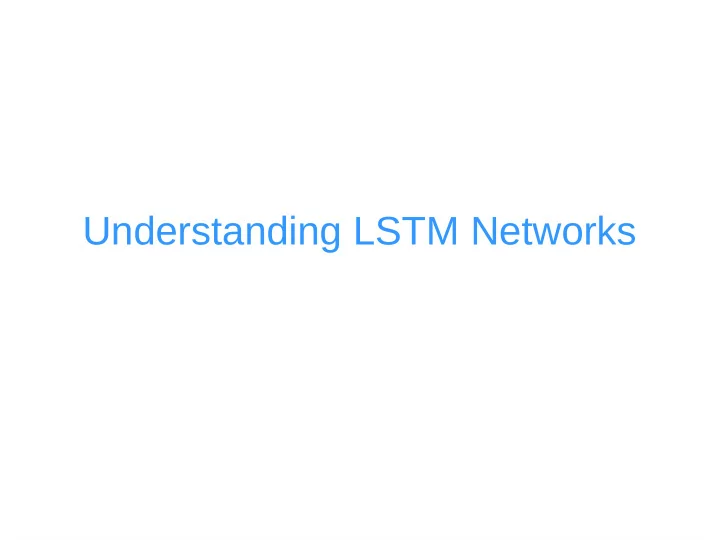

Understanding LSTM Networks
Recurrent Neural Networks
An unrolled recurrent neural network
The Problem of Long-Term Dependencies
RNN short-term dependencies Language model trying to predict the next word based on the previous ones the clouds are in the sky, h 0 h 1 h 2 h 3 h 4 A A A A A x 0 x 1 x 2 x 3 x 4
RNN long-term dependencies Language model trying to predict the next word based on the previous ones I grew up in India… I speak fluent Hindi. h 0 h 1 h 2 h t − 1 h t A A A A A x 0 x 1 x 2 x t − 1 x t
Standard RNN
Backpropagation Through Time (BPTT)
RNN forward pass s t = tanh ( Ux t + Ws t − 1 ) ^ y t = softmax ( Vs t ) V V V V V W W W W W y )=− ∑ U U U U U E ( y , ^ E t ( y t , ^ y t ) t
Backpropagation Through Time ∂ E t ∂ E ∂ W = ∑ ∂ W t ∂ E 3 ∂ W =∂ E 3 ∂ ^ y 3 ∂ s 3 ∂ ^ y 3 ∂ s 3 ∂ W s 3 = tanh ( Ux t + Ws 2 ) But S_3 depends on s_2, which depends on W and s_1, and so on. 3 ∂ E 3 ∂ ^ ∂ E 3 ∂ s 3 ∂ s k y 3 ∂ W = ∑ ∂ ^ ∂ s 3 ∂ s k ∂ W y 3 k = 0
The Vanishing Gradient Problem 3 ∂ E 3 ∂ ^ ∂ E 3 y 3 ∂ s 3 ∂ s k ∂ W = ∑ ∂ ^ ∂ s 3 ∂ s k ∂ W y 3 k = 0 3 ∂ E 3 ∂ s 3 ( ∏ ∂ s j − 1 ) ∂ ^ 3 ∂ E 3 y 3 ∂ s j ∂ s k ∂ W = ∑ ∂ ^ ∂ W y 3 k = 0 j = k + 1 ● Derivative of a vector w.r.t a vector is a matrix called jacobian ● 2-norm of the above Jacobian matrix has an upper bound of 1 ● tanh maps all values into a range between -1 and 1, and the derivative is bounded by 1 ● With multiple matrix multiplications, gradient values shrink exponentially ● Gradient contributions from “far away” steps become zero ● Depending on activation functions and network parameters, gradients could explode instead of vanishing
Activation function
Basic LSTM
Unrolling the LSTM through time
Constant error carousel s t = tanh ( Ux t + Ws t − 1 ) o t C t ⋅ o t Replaced by σ Π C t = ~ ( t ) + C t − 1 C t ⋅ i c σ Edge to next Π time step i t Edge from previous ~ σ C t time step (and current input) Weight fixed at 1
Input gate ● Use contextual information to decide Store input into memory ● Protect memory from overwritten ● by other irrelevant inputs o t C t ⋅ o t σ Π C t = ~ ( t ) + C t − 1 C t ⋅ i c σ Edge to next Π time step i t Edge from previous ~ σ C t time step (and current input) Weight fixed at 1
Output gate ● Use contextual information to decide Access information in memory ● Block irrelevant information ● o t C t ⋅ o t σ Π C t = ~ ( t ) + C t − 1 C t ⋅ i c σ Edge to next Π time step i t Edge from previous ~ σ C t time step (and current input) Weight fixed at 1
Forget or reset gate o t C t ⋅ o t σ Π f t σ C t = ~ ( t ) + C t − 1 ⋅ f t C t ⋅ i c Π σ Edge to next Π time step i t Edge from previous ~ σ C t time step (and current input) Weight fixed at 1
LSTM with four interacting layers
The cell state
Gates sigmoid layer
Step-by-Step LSTM Walk Through
Forget gate layer
Input gate layer
The current state
Output layer
Refrence ● http://colah.github.io/posts/2015-08-Understanding-LSTMs/ ● http://www.wildml.com/ ● http://nikhilbuduma.com/2015/01/11/a-deep-dive-into-recurrent-neural-netwo rks/ ● http://deeplearning.net/tutorial/lstm.html ● https://theclevermachine.files.wordpress.com/2014/09/act-funs.png ● http://blog.terminal.com/demistifying-long-short-term-memory-lstm-recurrent -neural-networks/ ● A Critical Review of Recurrent Neural Networks for Sequence Learning, Zachary C. Lipton, John Berkowitz ● Long Short-Term Memory, Hochreiter, Sepp and Schmidhuber, Jurgen, 1997 ● Gers, F. A.; Schmidhuber, J. & Cummins, F. A. (2000), 'Learning to Forget: Continual Prediction with LSTM.', Neural Computation 12 (10) , 2451-2471 .
Recommend
More recommend